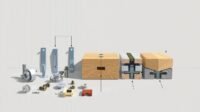Ceiling fans help keep your home cool but hanging a fan can be challenging, especially when you do it for the first time. To help you start, this article will cover the installation of a ceiling fan without a stud.
If your ceiling fan is not directly over a ceiling joist or stud, you’ll need to use a ceiling fan mounting bracket and anchors designed for this purpose. Here’s a general guide on how to hang a ceiling fan without a stud:
How to Hang a Ceiling Fan without a Stud
To help you get prepared for the installation process, gather the tools you need first. They are:
- Screwdriver
- Wire cutters
- Brace box
- Ladder
- Pliers
- Wrench
After that, lift the circuit breaker at the electrical box and make sure you turn off the power supply.

Pick Where You Will Hang the Ceiling Fan
Please choose a location to install the fan because it relates to the power supply. You may have an existing fan before, making the installation easier. You only need to disassemble the fixture and remove the fixtures. If you find the electrical box is already installed, you are lucky.
However, there is an option where you need to start a new fan installation. Thus, create a new wiring route through the attic access. If you cannot access it, create a small hole in the drywall to install the wiring.
Read also: How to Install a Bathroom Fan Without Attic Access
Install the Electrical Box
There are several steps needed before hanging the ceiling fan
- Ensure the electrical box is mounted to a ceiling joist. Do you find the ceiling joist is not accessible? Use a brace box that connects the two ceiling joists and supports the weight of your fan.
- Slip the brace to the ceiling, place it between the joists through the hole, and then secure it. Install the U-bolt assembly to the centre of the hole.
- Punch out the openings in the electrical box and feed the wires from the ceiling.
Install the wall switch, which is going to control the ceiling fan. Use fish tape to pull brand-new wiring through the new fan and the walls.
Assemble the Fan
Assemble the down rod in the canopy according to the instructions. Set the wires through the down rod, then tighten all the set screws. If you do not have a stud, the down rod can be held onto the motor using a metal bolt.
Raise the entire fan assembly to the ceiling mounting plate and seat the bulb into the socket. After that, connect the copper wire to the green ground wires on the fan base, then connect the white meter wires. Carefully push the wires up into the electrical box and cover it with the canopy.
Read also: The Difference Between Aluminum VS Copper Wire
Finally, attach the fan blades one by one to the assembly. Install the bulbs, turn the power back on, and ensure your ceiling fan operates properly.
Tips
- If possible, try to install the ceiling fan on a ceiling joist for added stability.
- Ensure the ceiling fan is balanced and does not wobble when operating.
- If unsure about the installation process, consult a professional electrician to ensure safety and compliance with local building codes.
Read also: Ceiling Fan: Installation and Maintenance Tips
Always refer to the specific instructions provided by the ceiling fan manufacturer, as different models may have variations in installation procedures.
After reading the article, you know how to mount the ceiling fan directly to the joist step-by-step. The installation’s success depends on the homeowner’s skill, so carefully read the guidelines and avoid faulty wiring.
If you are comfortable with the process, you can do it yourself. Yet, you can always contact the installation professionals to help you.


